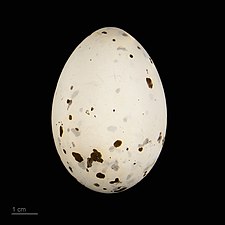Brown noddy
| Brown noddy | |
|---|---|

| |
| Anous stolidus pileatus, Queensland Australia | |
| Scientific classification | |
| Domain: | Eukaryota |
| Kingdom: | Animalia |
| Phylum: | Chordata |
| Class: | Aves |
| Order: | Charadriiformes |
| Family: | Laridae |
| Genus: | Anous |
| Species: | A. stolidus
|
| Binomial name | |
| Anous stolidus | |

| |
| Synonyms | |
|
Sterna stolida Linnaeus, 1758 | |
The brown noddy or common noddy (Anous stolidus) is a
Taxonomy
The first formal description of the brown noddy was by the Swedish naturalist Carl Linnaeus in 1758 in the tenth edition of his Systema Naturae under the binomial name Sterna stolida.[3] The genus Anous was introduced by the English naturalist James Francis Stephens in 1826.[4] The genus name Anous is Ancient Greek for "stupid" or "foolish". The specific name stolidus is Latin and also means "stupid" or "foolish".[5]
Four subspecies are recognised:[6]
- A. s. pileatus (Scopoli, 1786) – Red Sea, Indian Ocean east through the Pacific to Hawaii & Easter Island
- A. s. galapagensis Sharpe, 1879 – Galápagos Islands
- A. s. ridgwayi Anthony, 1898 – islands off western Mexico to Costa Rica
- A. s. stolidus (Linnaeus, 1758) – islands of the Caribbean and tropical Atlantic
-
A. s. pileatus, Queensland, Australia
-
A. s. galapagensis,endemic to the Galápagos Islands, Ecuador
-
A. s. stolidus, São Tomé and Príncipe
Description
The brown noddy is 38–45 cm (15–18 in) in length with a wingspan of 75–86 cm (30–34 in). The plumage is a dark chocolate-brown with a pale-grey or white crown and forehead. It has a narrow incomplete white eye-ring.[7] The tail is long and wedge-shaped, and the feet and legs are dark.[8]
Behaviour
Breeding
The brown noddy is a colonial bird, usually nesting on cliffs, trees, or bushes. It occasionally lays its eggs on the bare ground. The nest itself is usually a
In their nuptial displays, the female and male bow and nod to each other. Courtship feeding and flights accompany this, in addition to the transfer of a small, freshly caught fish from the male to the female.[9]
This bird lays a clutch of one pink cream egg with lilac and chestnut maculation. The egg usually measures around 52 by 35 millimetres (2.0 by 1.4 in). This egg is incubated by both sexes for 33 to 36 days, with each parent incubating for one or two days while their mate is feeding at sea. After the chick hatches, it grows quickly; usually reaching the weight of the parents in three weeks.[9] When it fledges, about six to seven weeks after hatching,[8] it can sometimes weigh more than the parents, although this weight is lost quickly once it starts to fly. At this point, the fledgling is starting to rely on its parents less and less as it learns how to provide for itself.[9]
-
Egg
-
A. s. pileatus, Philippines
-
A. s. pileatus with chick
-
A. s. stolidus with chick
-
A. s. stolidus, São Tomé and Príncipe
Diet
The brown noddy forages by swooping over the water and dipping down to catch small squid, other molluscs, aquatic insects and fish (such as
References
- . Retrieved 12 November 2021.
- ^ KA Shaji (13 May 2020). "Lakshadweep gets world's first sea cucumber conservation reserve to curb smuggling into China". Scroll. Retrieved 23 July 2020.
- ^ Linnaeus, C. (1758). Systema Naturæ per regna tria naturae, secundum classes, ordines, genera, species, cum characteribus, differentiis, synonymis, locis, Volume 1 (in Latin). Vol. v.1 (10th ed.). Holmiae:Laurentii Salvii. p. 137.
- ^ Stephens, James Francis (1826). General zoology, or Systematic natural history, by George Shaw. Vol. 13. London: G. Kearsley. p. 139. The title page gives the year as 1825.
- ISBN 978-1-4081-2501-4.
- ^ Gill, Frank; Donsker, David, eds. (2019). "Noddies, gulls, terns, auks". World Bird List Version 9.2. International Ornithologists' Union. Retrieved 24 June 2019.
- ^ Gochfeld, M.; Burger, J.; Kirwan, G.M.; Garcia, E.F.J. "Brown Noddy (Anous stolidus)". In del Hoyo, J.; Elliott, A.; Sargatal, J.; Christie, D.A.; de Juana, E. (eds.). Handbook of the Birds of the World Alive. Lynx Edicions. Retrieved 17 April 2017.
- ^ ISBN 0-75258-734-X.
- ^ ISBN 978-0-226-05781-1.
- ^ a b https://sta.uwi.edu/fst/lifesciences/sites/default/files/lifesciences/images/Anous%20stolidus%20-%20Brown%20Noddy%20or%20Common%20Noddy.pdf [bare URL PDF]
Sources
- "National Geographic" Field Guide to the Birds of North America ISBN 0-7922-6877-6
- Harrison, P. Seabirds, an Identification Guide (1983) ISBN 0-7470-1410-8
- Sibley, D. A., ISBN 0-679-45122-6
- Chardine, J.W. and R.D. Morris. 1996. Brown Noddy (Anous stolidus). In: The Birds of North America, No. 220 (A. Poole and F. Gill, eds.). The Academy of Natural Sciences, Philadelphia, PA, and The American Ornithologists' Union, Washington, D.C.
- Brown, William Yancey (1973). Breeding Biology of the Sooty Tern and Brown Noddy on Manana or Rabbit Island, Hawaii. Ph.D. Dissertation, University of Hawaii.[1]









